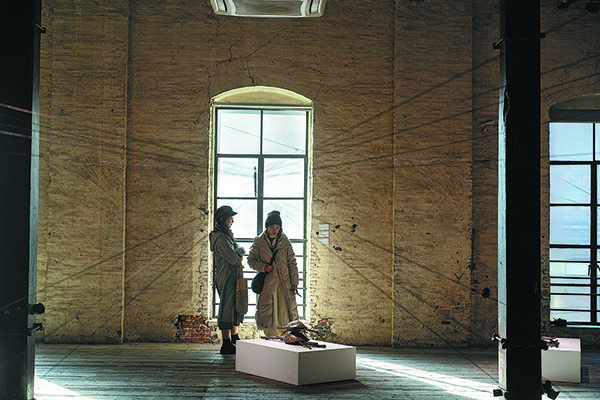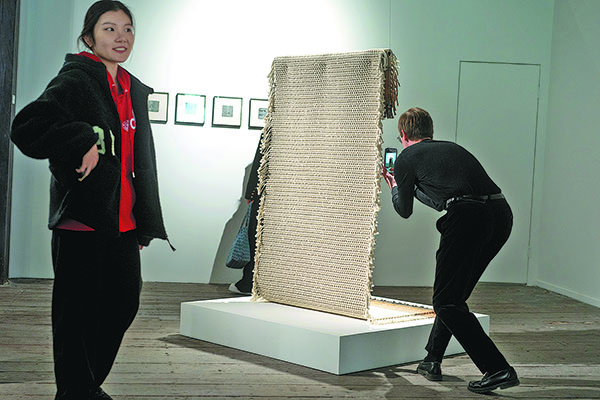
News & Events

News & Events

Visitors admire work by Italian artist Virginia Russolo (a 3-D printed turtle shell, forefront), as well as Edoardo Dionea Cicconi's installation, a web-like Portal. [Photo provided to China Daily]
An ongoing exhibition at the Bridge Eight Art Space is presenting creations by five visiting artists who are part of the 2023 ICCI Art Valley Program.
The Institute of Cultural and Creative Industry, a joint project between the University of South California and Shanghai Jiao Tong University, started the program in 2018.Every year, the program recruits artists from all over the world for a residency that allows them to learn about Chinese culture and experience Shanghai's art season.
This year, five artists were selected and the artworks that they have created during the residency are being featured at the exhibition titled Remnants of the Unknowable, which kicked off on Dec 1 and will run until Dec 15 at Bridge Eight Art Space, a renovated granary on the Suzhou Creek.
The institute launched the art valley project in the hope of creating a multi-dimensional artistic dialogue, and a platform for academic exchange, that would enable artists, designers, engineers and other creative talent to explore new methods and technologies, said Zhang Weimin, director of the ICCI, at the opening of the exhibition.
"Each year, the Art Valley program features brand-new experiments and new experiences," says Wu Fan, an associate professor at the institute. "The exhibition every year is like a pearl, carefully selected and polished, shining with the ingenuity of each artist. All these pearls are then strung up to form a necklace. This is how art keeps evolving and developing, reaching more people, and delivering beautiful experiences."
Wu says that this year the organizer selected the five artists from a field of 300 applicants. The five artists are art scholar Virginia Russolo and installation artist Edoardo Cicconi from Italy, Polish textile artist Jakub Swiecicki and Chinese artists Hu Rui and Li Tingwei.
"They have participated in international art festivals and events in Shanghai, had academic interactions with university students, and immersed themselves in the urban culture of Shanghai over the past month," says Wu.
"We are living in an era of information, and everyone is in the midst of an unprecedented wave of cultural exchange and innovation," Wu adds, explaining the theme for this year's exhibition.
"While technology seems to have brought an infinite amount of new knowledge, the realm of the unknown gains significance as the core for new exploration and imagination."

At the opening ceremony, Russolo said that she is interested in materials, especially animal-related ones, that are used in ritual settings, and that she had, during the residency, learned about the oracle bones from the Shang Dynasty (c. 16th century-11th century BC) and was intrigued by the fact that turtle shells are a material often featured in Chinese mythology.
She also discovered new materials for her creation, such as certain silk fabrics that she cannot find in Europe, as well as wax extracted from the seeds of the lacquer tree in Yunnan province.
Inspired by the powerful imagery of the oracle bones, the Italian combines 3D printing technology with handmade creations in collaboration with the Shanghai Jiao Tong University Student Innovation Center, and has developed a series of installations that vividly demonstrate the potential of combining art and science.
Polish art scholar Swiecicki is showcasing a hand-woven carpet, as well as a work that was created with the help of computer graphics programs. He says he had used natural materials to dye the fiber before handweaving them into carpets. It takes him three months to make a single carpet, and the arduous working process was akin to meditation, he says.
Meanwhile, Italian artist Cicconi has created a site-specific installation for the exhibition. His work, titled Portal, consists of laser-cut glass mirrors on two side walls and metal wires and rings in the center. Together they form a perceptible spatial dimension of points, lines and surfaces, and a time-space corridor of past, present and future.
If you have any problems with this article, please contact us at app@chinadaily.com.cn and we'll immediately get back to you.

SCHOOL OF PHARMACY,SJTU
Address: 800 Dongchuan Road, Shanghai
200240